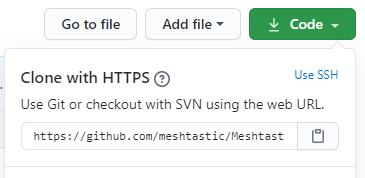This project uses the simple PlatformIO build system. PlatformIO is an extension to Microsoft VSCode. Workflows from building from the GUI or from the command line are listed below.
If you encounter any problems, please post a question in [our forum](https://meshtastic.discourse.group). And when you learn a fix, update these instructions for the next person (i.e. edit this file and send in a [pull-request](https://opensource.com/article/19/7/create-pull-request-github) which we will eagerly merge).
## GUI
1. Purchase a suitable [radio](https://github.com/meshtastic/Meshtastic-device/wiki/Hardware-Information).
6. Click the PlatformIO icon on the side bar. 
7. Under `Quick Access, Miscellaneous, Clone Git Project` enter the URL of the Meshtastic repo found [here](https://github.com/meshtastic/Meshtastic-device). 
8. Select a file location to save the repo.
9. Once loaded, open the `platformio.ini` file.
10. At the line `default_envs` you can change it to the board type you are building for ie. `tlora-v2, tlora-v1, tlora-v2-1-1.6, tbeam, heltec, tbeam0.7` (boards are listed further down in the file).
11. The hardware can be configured for different countries by adding a definition to the `configuration.h` file. `#define HW_VERSION_US` or `HW_VERSION_EU433, HW_VERSION_EU865, HW_VERSION_CN, HW_VERSION_JP`. Other country settings can be found in `MeshRadio.h`. The default is `HW_VERSION_US`.
12. Click the PlatformIO icon on the side bar. Under `Project Tasks` you can now build or upload.
Note - To get a clean build you may have to delete the auto-generated file `./.vscode/c_cpp_properties.json`, close and re-open Visual Studio and WAIT until the file is auto-generated before compiling again.
## Command Line
1. Purchase a suitable [radio](https://github.com/meshtastic/Meshtastic-device/wiki/Hardware-Information).
4. Run `git submodule update --init --recursive` to pull in dependencies this project needs.
5. If you are outside the USA, run "export COUNTRY=EU865" (or whatever) to set the correct frequency range for your country. Options are provided for `EU433`, `EU865`, `CN`, `JP` and `US` (default). Pull-requests eagerly accepted for other countries.
6. Plug the radio into your USB port
7. Type `pio run --environment XXX -t upload` (This command will fetch dependencies, build the project and install it on the board via USB). For XXX, use the board type you have (either `tlora-v2, tlora-v1, tlora-v2-1-1.6, tbeam, heltec, tbeam0.7`).
8. PlatformIO also installs a very nice VisualStudio Code based IDE, see their [tutorial](https://docs.platformio.org/en/latest/tutorials/espressif32/arduino_debugging_unit_testing.html) if you'd like to use it.